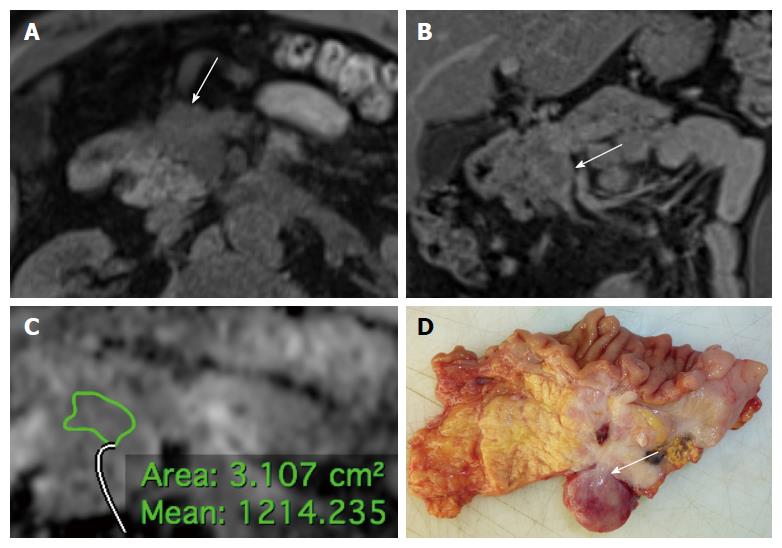Copyright
©The Author(s) 2017.
World J Gastroenterol. Jan 14, 2017; 23(2): 275-285
Published online Jan 14, 2017. doi: 10.3748/wjg.v23.i2.275
Published online Jan 14, 2017. doi: 10.3748/wjg.v23.i2.275
Figure 2 Non-hyperfunctioning pancreatic neuroendocrine neoplasm of the pancreatic head classified as G2, stage 3b tumor at histology (Ki67 15%, T4, N1, M0) in a 55 years-old man.
A: Axial volumetric interpolated breath-hold examination (VIBE) gradient echo image (repetition time msec/echo time msec, 4.3/1.4) with fat suppression shows a hypointense tumor with ill-defined margins (arrow); B: On coronal fat-saturated T1-weighted volumetric interpolated breath-hold examination (VIBE) gradient echo image (TR/TE 3.5/1.3 ms) acquired during the delayed phase of the dynamic study the tumor shows heterogeneous contrast enhancement, with infiltration of the superior mesenteric vein (arrow); C: The tumor presents intermediate mean ADC value; D: The surgical specimen (pancreaticoduodenectomy with en bloc resection of the superior mesenteric vein, transverse cut) shows a large lesion of the pancreatic head with irregular margins infiltrating the superior mesenteric vein (arrow).
- Citation: De Robertis R, Cingarlini S, Tinazzi Martini P, Ortolani S, Butturini G, Landoni L, Regi P, Girelli R, Capelli P, Gobbo S, Tortora G, Scarpa A, Pederzoli P, D’Onofrio M. Pancreatic neuroendocrine neoplasms: Magnetic resonance imaging features according to grade and stage. World J Gastroenterol 2017; 23(2): 275-285
- URL: https://www.wjgnet.com/1007-9327/full/v23/i2/275.htm
- DOI: https://dx.doi.org/10.3748/wjg.v23.i2.275









